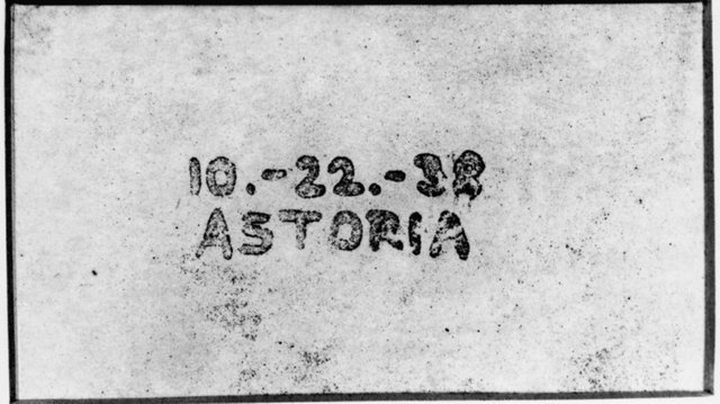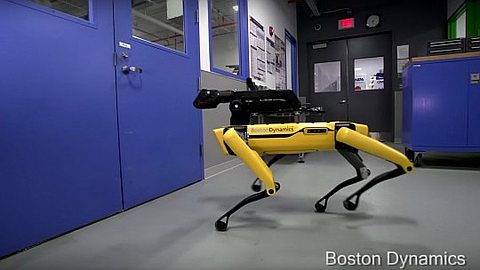How This 75 Year-Old Piece of Paper Started Modern Computing

In the intervening 75 years, the copier industry would become a mainstay of Corporate America. Even in our current age of tablets and PDFs, businesses bought 19 million "multifunction printers" last year for a total of $30.9 billion, according to Gartner. You may not recall the last time that you made a copy, but IDC analyst Angèle Boyd says the world printed 3 trillion pieces of paper last year — 1 trillion of which came from the U.S. It's also not unusual for employees at some businesses to print as many as 300 to 400 copies a month. While printing remains a surprisingly robust business, though, the real revolution Carlson started went way beyond his analog invention.
The electrophotographic print Carlson made would prompt the invention of the copier, which made offices more productive and made the replicable document a fixture of business communication. As Ken Weilerstein, VP of research, imaging and print services at Gartner notes, most white collar workers' days consist of reading and creating documents of one form or another. The web was originally based on hypertext, a method of linking documents on a computer, that Tim Burners-Lee joined to the Internet in 1991.
"What the copier did is it changed the way people handled documents," he says, "which is a big piece of what people in offices do."
The Rise of Xerox
Xerox is the best known copier company and the one still synonymous with the industry for many. Like Google, Xerox's name has been made into a lower-case verb as in "I need this xeroxed." In tech circles, Xerox is also infamous for developing the graphic user interface and the mouse in its Palo Alto Research Center in the 1970s. Steve Jobs would famously visit PARC and appropriate many of the ideas for what became the Macintosh computer. Relatedly, Carlson's invention was adapted to create the laser printer as well.
No one ever formed a company called Xerox, though. Instead, Carlson's invention would transform a company called Haloid that would eventually rename itself.
As the story goes, Carlson, a serial inventor and patent attorney, got tired of copying legal documents manually. He concluded that there must be a way to make copies without relying on carbon paper or the traditional, messy, slow and expensive photographic process of using wet, sensitized paper and water. Ray Brewer, Xerox's historical archives manager, says Carlson's solution — which involved zinc plates and powder — was simple and fairly easy to replicate.
(As Weilerstein, explains it, the process works like this: A page is exposed to a light source, which sweeps across the page, illuminating the original paper document. The reflection is projected through a set of lenses to an electrophotograhic drum, which is coated with light-sensitive material. The drum's exposure to light changes its electrostatic charge, leaving an image of the page on the drum as an electrostatic charge. The drum then rotates and the charged areas of the page attract the toner particles, effectively painting the image on the drum with toner. The drum then transfers the toner onto a sheet of paper, which is heated and pressed at a temperature similar to that of an iron. Finally, the drum rotates and excess toner is scraped off and the process is repeated for the next page.)
Perhaps it was too easy. Though Carlson was in a celebratory mood after his breakthrough, Kornei didn't see the appeal. When Kornei's contract ran out, he broke ties with Carlson. "He couldn't see what the purpose of it was," Brewer says. Kornei would remain a lifelong skeptic.
Later on, when Carlson gave Kornei 100 shares in Xerox, Kornei quickly sold them, missing out on a payday of more than $1 million.
For years, Carlson peddled his invention to dozens of companies, including IBM and Eastman Kodak, but no one else saw the appeal, either. Brewer says the problem was that Carlson was a techie, not a salesman. "The way Chester was presenting the idea and demos were very dry and technical," Brewer says. It didn't help that Carlson was making his pitch to marketing executives. However even engineers were often befuddled by Carlson's presentations.
Carlson's big break came in 1946, when John Dessauer, chief of research at the Haloid Co. in Rochester, N.Y., read an article about Carlson's invention. Haloid, which made photographic paper, but by then "the photographic realm of things had pretty much run its course," Brewer says. In 1948, Haloid looked for a catchier way to promote Carlson's invention, which was known as "electrophotography." The company's pr department settled on "xerography," a portmanteau of the Greek "xeros" ("dry") and "graphos" ('writing.")
Over the course of the 1950s and 1960s, the Xerox copier became a staple of office life. The innovation saved time and money. Previously, the only way to make copies was to use a photostat machine, which was messy and expensive or worse, carbon paper, which could only make at best two copies at a time. If you wanted more than that then someone had to type out another version "and the secretary or administrator had to hope that everything was exactly the same," Brewer says. There were other benefits as well. Way before email and instant messaging, the office copier provided the first opportunity for office-wide communication in written form. The Xerox gave birth to the memo, the office newsletter and holiday cards.
The 914 was Xerox's most successful model. Between 1960 and the early 1970s, the company sold more than 200,000 units, prompting Fortune to dub it "the most-successful product ever marketed in America." Xerox became known as "the stock you wish you'd bought," Weilerstein says.
Here's an ad from circa 1960:
The Modern Computing Era
This Mad Men era would come to a close in the 1980s as PCs began replacing typewriters. Carlson's invention would also be used to create the laser printer, which obviated single-function copiers. As a result, no one in the industry calls Xerox's machines copiers anymore. Instead, they are known as "multifunction printers."
That wasn't the only threat to Xerox's business. By the 1970s, Japanese competitors were offering their own cheaper version of Xerox's copiers. Xerox lost its effective monopoly, but managed to stay on the cutting edge of technology, Weilerstein says, by developing its own laser printer business. Then in 1990, Xerox introduced Docutech, a technology that let you turn a printer effectively into a printing press. Xerox scored another coup in 2000 with iGen, a color laser printer that could spit out 100 pages a minute. "By the mid-2000s, they didn't have anything exclusive at all," Weilerstein says, "and they began suffering economically."
Xerox wasn't hit as hard as its Rochester neighbor, Eastman Kodak, which is now a shadow of its former self.
Partially that's because — unlike film — printing paper documents remains a lucrative business. There are sectors of the economy — including the federal government — where employees still print a few thousand pages a month. Weilerstein acknowledges that the use of print will continue to decline over time. "It's probably a generational factor," he says. However "it isn't really disappearing."
Bolstered by the continued need for multifunction printers, Xerox has the opportunity to reinvent itself as a provider of primarily digital documents and services. The company laid the groundwork for such a move by embracing the managed print services business in the last decade. MPS essentially outsources the printing aspect of the office and gives IT departments one less task to monitor.
However, since paper printing is on a long-term downward trend, Xerox is trying to anticipate where the market will go next. "Now the question is what will they do after this," says Weilerstein. "They will take this idea of a service that manages your printers and turn that into a service that handles how you handle docs in digital form."
" I think there's a great desire among IT [departments] to get rid of paper
I think there's a great desire among IT [departments] to get rid of paper," says the IDC's Boyd. "A lot of people, including Xerox, are actively trying to help them."
Weilerstein's view is that since all communication is basically documents, Xerox has a chance to become a leader in "managed content services." Such services would help organizations cut down on the use of print. Though paper is still a useful communications medium, many printed pages are symptoms of problems involving poor interconnection between the different sources of information where workers obtain information and the different destinations to which they must apply it," Weilerstein wrote in a recent white paper on the subject.
MCS would address the advertising orders that a broadcast network still receives by fax or provide a means to let a chemical manufacturer's employees scan their handwritten notes into a searchable digital archive.
Carlson's Legacy
In promoting a largely paperless future, Xerox would not only transition its business but help cut down on needless waste. However, the company has lots of competition on the document front, most notably from Adobe, the inventor of the Portable Document Format (PDF).
Adobe, whose legacy is in desktop printing rather than hardware, appears to have a natural advantage over Xerox. Apple aside, it's rare that a company associated with the invention of an old technology manages to also become a leader in the technology that replaces it.
Yet even if Xerox ultimately fails, Carlson's contribution to tech history is assured, if a bit obscure to most. A serial inventor, Carlson didn't have much to show for his other ideas — including a raincoat with gutters and a shoe-cleaning machine — but his one great invention is a testament to how the market rewards perseverance and vision. His death was an illustration of how little we sometimes know of the inner life of public figures.
Almost exactly 30 years after Carlson and Kornei slaved over their invention in that Astoria apartment, Carlson took a trip back to New York from his Rochester home for a business meeting. Finding he had some down time, he ducked into a movie theater to catch He Who Rides a Tiger featuring Tom Bell and Judi Dench. After the movie, an usher saw Carlson, who appeared to be dozing in his seat. He hadn't. Carlson succumbed to a heart attack — his second that year.
He died with an estimated fortune of $150 million, making him one of the wealthiest men in the country in 1968. That estimate was wrong, though. Carlson had actually given away much of his wealth by then. As he told his wife, Carlson had a curious ambition for a business titan. He wanted to "die a poor man."





